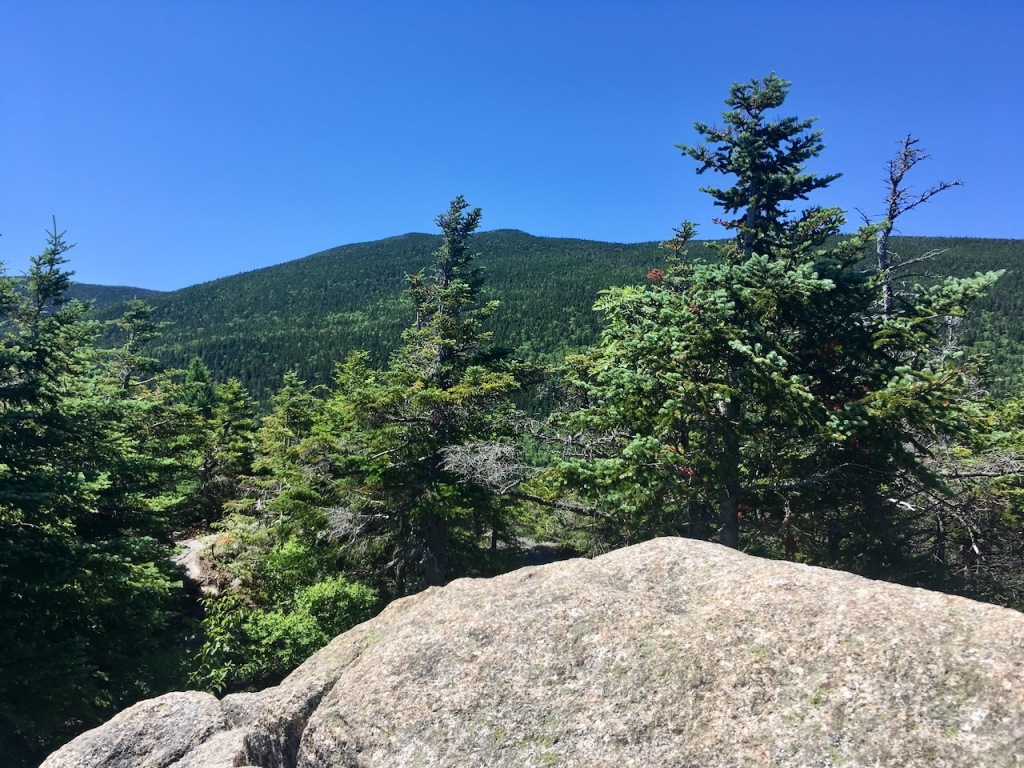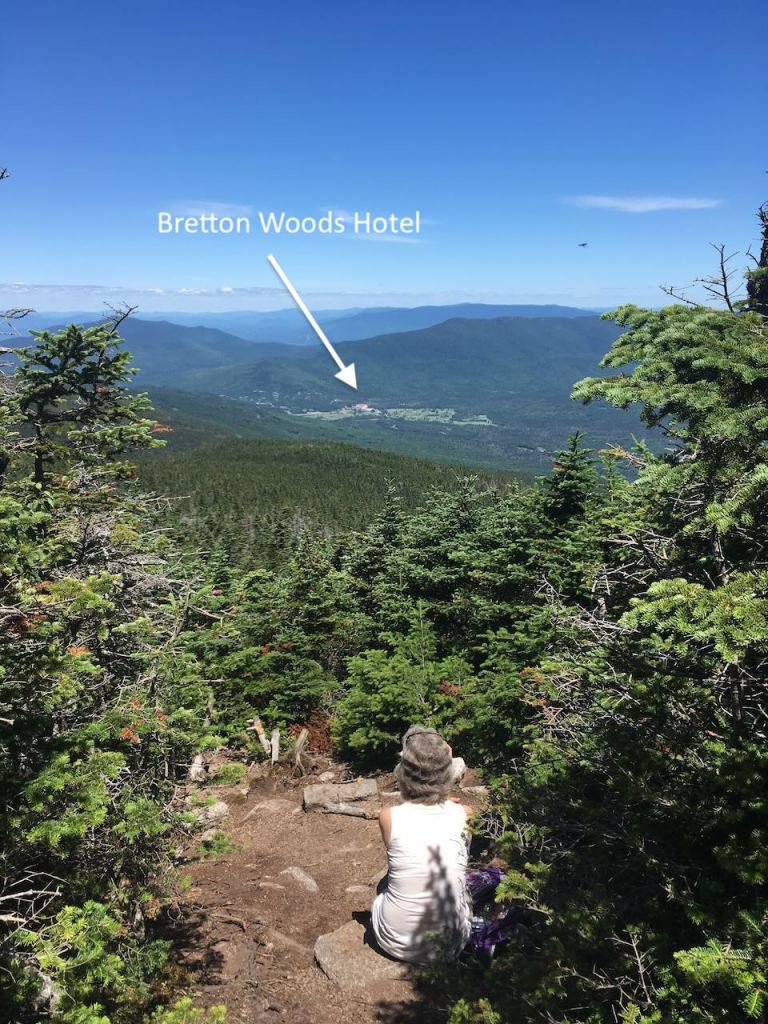Between June, 2016 and June, 2018 I climbed all 48 of New Hampshire’s 4000-foot mountains. This is called “peak-bagging” by local climbers. Most of my climbs were solo, but sometimes I hiked with a friend or two.
During that time, I wrote a series of blog posts in which I described, chronologically, the ascent of each of these peaks in words, images and a few videos. Along with the climb, in each post I shared some reflections on my work in international development during the MDG era: what it was like in the sector as it boomed, and evolved, from the response to the Ethiopian crisis in the mid-1980’s through to the conclusion of the Millennium Development Goals in 2015.
After finishing climbing all of the 48, with the ascent of Mt Jefferson on June 28, 2018, I have revisited these mountains – often in different seasons and using different trails. I’m writing up these later climbs separately.
My first climb of Mt Field (4006ft, 1221m) had been in August of 2017. My initial write-up of the hike included, along with a description of the climb, the most innovative, and difficult, aspect of ChildFund Australia’s “development effectiveness framework”: the notion of “power” – “building the power of poor people and poor children.”
I climbed Mt Field again on 19 July, 2018, after having completed all 48 of New Hampshire’s 4000-footers earlier that month.
I wondered how it would feel to start the cycle anew. It felt good! It had been a bit over 2 years since I had climbed Tom and Field, and some things had changed…
This time it was mid-summer instead of late spring, so no snow or ice on the ground. And, this time, I climbed Mt Field first, going around Avalon and A-Z trails clockwise instead of counter-clockwise as I had done in 2016.
It was a spectacular day, clear skies and cool temperatures. I drove up from Durham, leaving at 7am, arriving at the trail-head in Crawford Notch about 2 1/2 hours later. Since I had climbed Tom and Field last time, I had established a tradition of stopping for coffee and a Subway sandwich on the way north – which I did this time, too.
It was a beautiful summer day, warm and clear, with great views from the tops. As I hiked up, I did notice many more tree-falls than I had remembered, perhaps due to the severe storms we had here in March 2018.
In my original article I briefly mentioned having fallen on ice and wrenching my shoulder. That was descending from Mt Field; this time, going up Mt Field, I came across that area and took a moment to reflect on having learned my lesson!
I left Crawford Station at 10am, and headed up the Avalon Trail:

Evidence of high winds, that I don’t remember having seen two years earlier:

After 40 minutes, I came to the junction with the A-Z Trail. Here I would continue on the Avalon Trail, left, to reach Mt Avalon and then Mt Field. In 2016 I had gone right here, up to Mt Tom first:

The trail became very steep. I took one wrong turn near here, in the middle of a big and recent tree blow-down, and had to double back. Lost 15 minutes or so, and some sweat!


At 11:15am I reached the top of Mt Avalon, with fantastic views towards the Presidential Range:

And down Crawford Notch:

And over to Mt Tom, which I would reach after first getting to the top of Mt Field:

Down off of Mt Avalon, I rejoined the Avalon Trail and continued another mile to Mt Field:

The top of Mt Field was crowded, and unremarkable. There were a couple of groups of parents and young hikers – good to see them up here, but I decided to have half of my lunch nearby rather than at the summit cairn. Which is surrounded by trees, anyway!
Near the summit there is one view north, towards the Mt Washington Hotel in Bretton Woods. It was just after noon, and there was another hiker enjoying her lunch:

I had half of my Subway sandwich here, and then got back onto the trail, now moving on the Willey Ridge Trail towards Mt Tom:


Climbing Mt Field again was great, especially because it was a glorious day. I was able to note where I had fallen last time, on the mid-May snow of 2016, wrenching my shoulder, but generally it was a very peaceful and happy day.
Here are links to all the posts in this series. There is one post for each of the 48 4000-footers, covering my first climb of that particular mountain and also reflecting on a career in international development. And there are several other posts covering subsequent, repeat climbs which are usually done on alternate routes in different seasons:
- Mt Tom (1) – A New Journey;
- Climbing Mt Tom Again;
- Mt Field (2) – Potable Water in Ecuador;
- Climbing Mt Field Again;
- Mt Moosilauke (3) – A Water System for San Rafael (part 1);
- Climbing Mt Moosilauke Again;
- Mt Flume (4) – A Windmill for San Rafael (part 2);
- Mt Liberty (5) – Onward to Colombia, Plan International in Tuluá;
- Mt Osceola (6) – Three Years in Tuluá;
- East Osceola (7) – Potable Water for Cienegueta;
- Mt Passaconaway (8) – The South America Regional Office;
- Mt Whiteface (9) – Empowerment!;
- North Tripyramid (10) – Total Quality Management for Plan International;
- Middle Tripyramid (11) – To International Headquarters!;
- North Kinsman (12) – Fighting Fragmentation and Building Unity: New Program Goals and Principles for Plan International;
- South Kinsman (13) – A Growth Plan for Plan International;
- Mt Carrigain (14) – Restructuring Plan International;
- Mt Eisenhower (15) – A Guest Blog: Max van der Schalk Reflects on 5 Years at Plan’s International Headquarters;
- Mt Pierce (16) – Four Years At Plan’s International Headquarters;
- Mt Hancock (17) – Hanoi, 1998;
- South Hancock (18) – Plan’s Team in Viet Nam (1998-2002);
- Wildcat “D” Peak (19) – Plan’s Work in Viet Nam;
- Wildcat Mountain (20) – The Large Grants Implementation Unit in Viet Nam;
- Middle Carter (21) – Things Had Changed;
- South Carter (22) – CCF’s Organizational Capacity Assessment and Child Poverty Study;
- Mt Tecumseh (23) – Researching CCF’s New Program Approach;
- Mt Jackson (24) – The Bright Futures Program Approach;
- Mt Isolation (25) – Pilot Testing Bright Futures;
- Mt Lincoln (26) – Change, Strategy and Culture: Bright Futures 101;
- Mt Lafayette (27) – Collective Action for Human Rights;
- Mt Willey (28) – Navigating Principle and Pragmatism, Working With UUSC’s Bargaining Unit;
- Cannon Mountain (29) – UUSC Just Democracy;
- Carter Dome (30) – A (Failed) Merger In the INGO Sector (1997);
- Galehead Mountain (31) – What We Think About When We Think About A Great INGO Program;
- Mt Garfield (32) – Building Strong INGO Teams: Clarity, Trust, Inspiration;
- Mt Moriah (33) – Putting It All Together (Part 1): the ChildFund Australia International Program Team;
- Owls’ Head (34) – Putting It All Together (Part 2): ChildFund Australia’s Theory of Change;
- Bondcliff (35) – ChildFund Australia’s Development Effectiveness System;
- West Bond (36) – “Case Studies” in ChildFund Australia’s Development Effectiveness System;
- Mt Bond (37) – Impact Assessment in ChildFund Australia’s Development Effectiveness System;
- Mt Waumbek (38) – “Building the Power of Poor People and Poor Children…”
- Mt Cabot (39) – ChildFund Australia’s Teams In Cambodia, Laos, Myanmar, Papua New Guinea, and Viet Nam;
- North Twin (40) – Value for Money;
- South Twin (41) – Disaster Risk Reduction;
- Mt Hale (42) – A “Golden Age” for INGOs Has Passed. What Next?;
- Zealand Mountain (43) – Conflict: Five Key Insights;
- Mt Washington (44) – Understanding Conflicts;
- Mt Monroe (45) – Culture, Conflict;
- Mt Madison (46) – A Case Study Of Culture And Conflict;
- Mt Adams (47) – As I Near the End of This Journey;
- Mt Jefferson (48) – A Journey Ends…

Couldn’t finish looking at all the links. I stopped at link 41. Sorry!
Just take it slow, a few links a day. You’ll get there!
Pingback: Mt Tom (1) – A New Journey | Mark McPeak
Pingback: Mt Field (2) – Potable Water in Ecuador | Mark McPeak
Pingback: Climbing Mt Moosilauke Again | Mark McPeak
Pingback: Climbing Mt Carrigain Again | Mark McPeak
Pingback: Mt Carrigain (14) – Restructuring Plan International | Mark McPeak
Pingback: Mt Moosilauke (3) – A Water System for San Rafael (part 1) | Mark McPeak
Pingback: Climbing Mt Tom Again | Mark McPeak